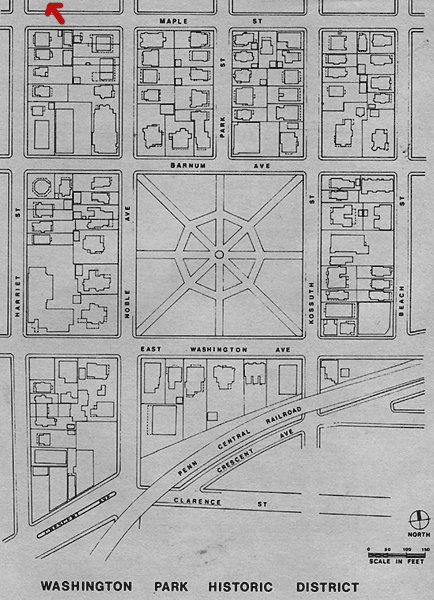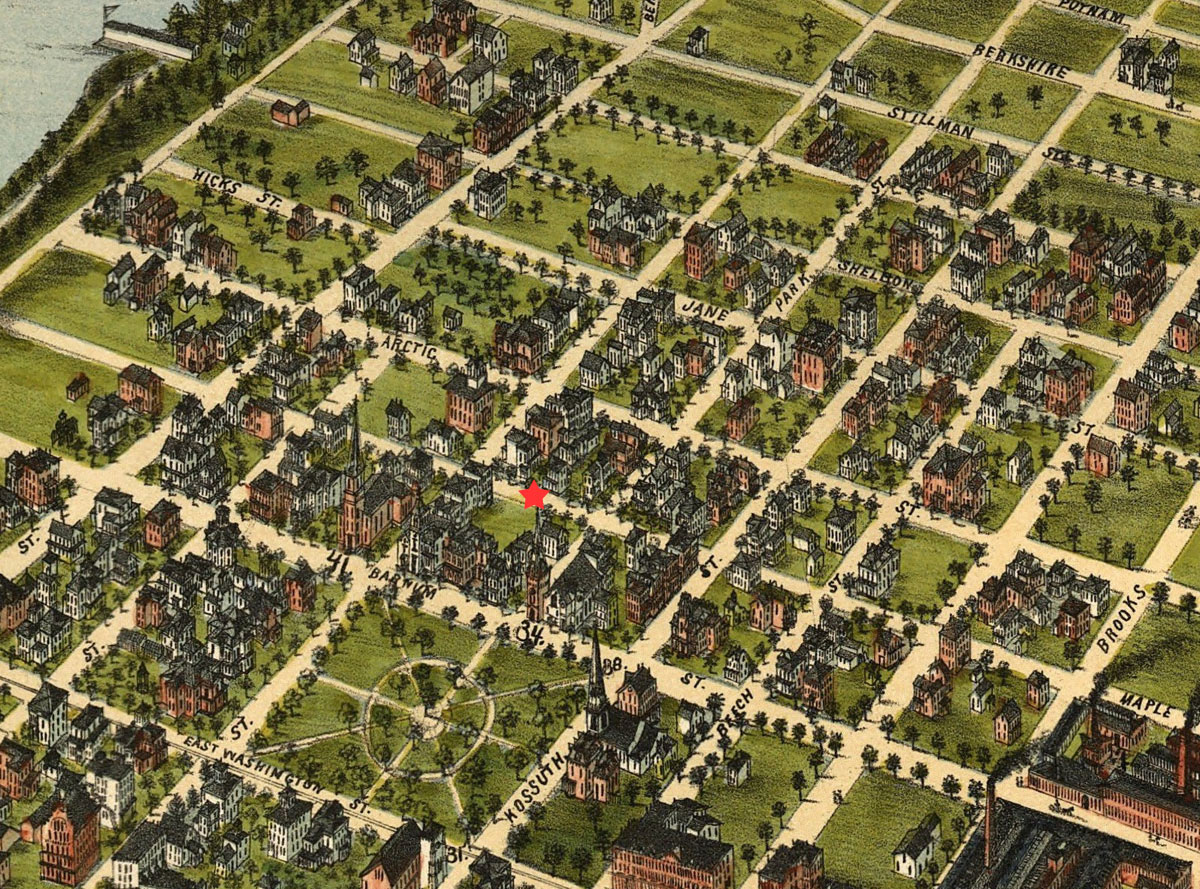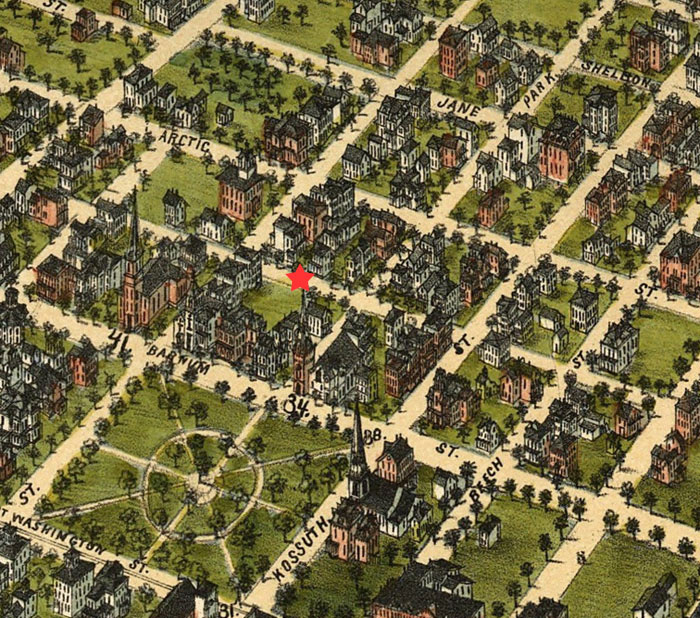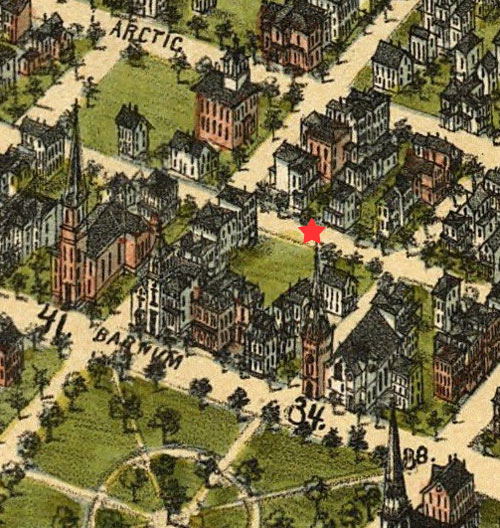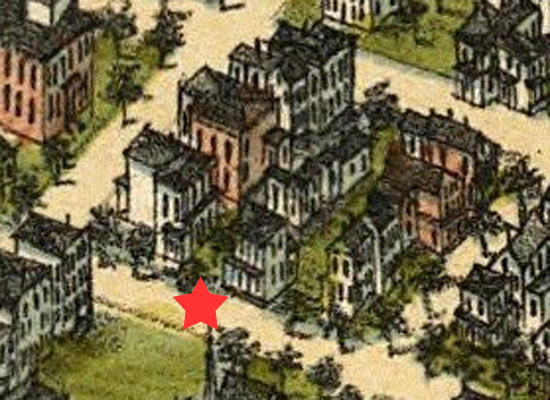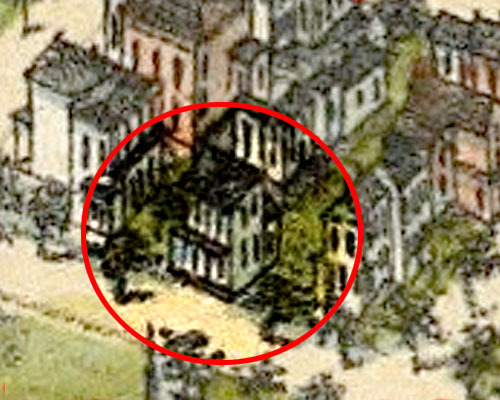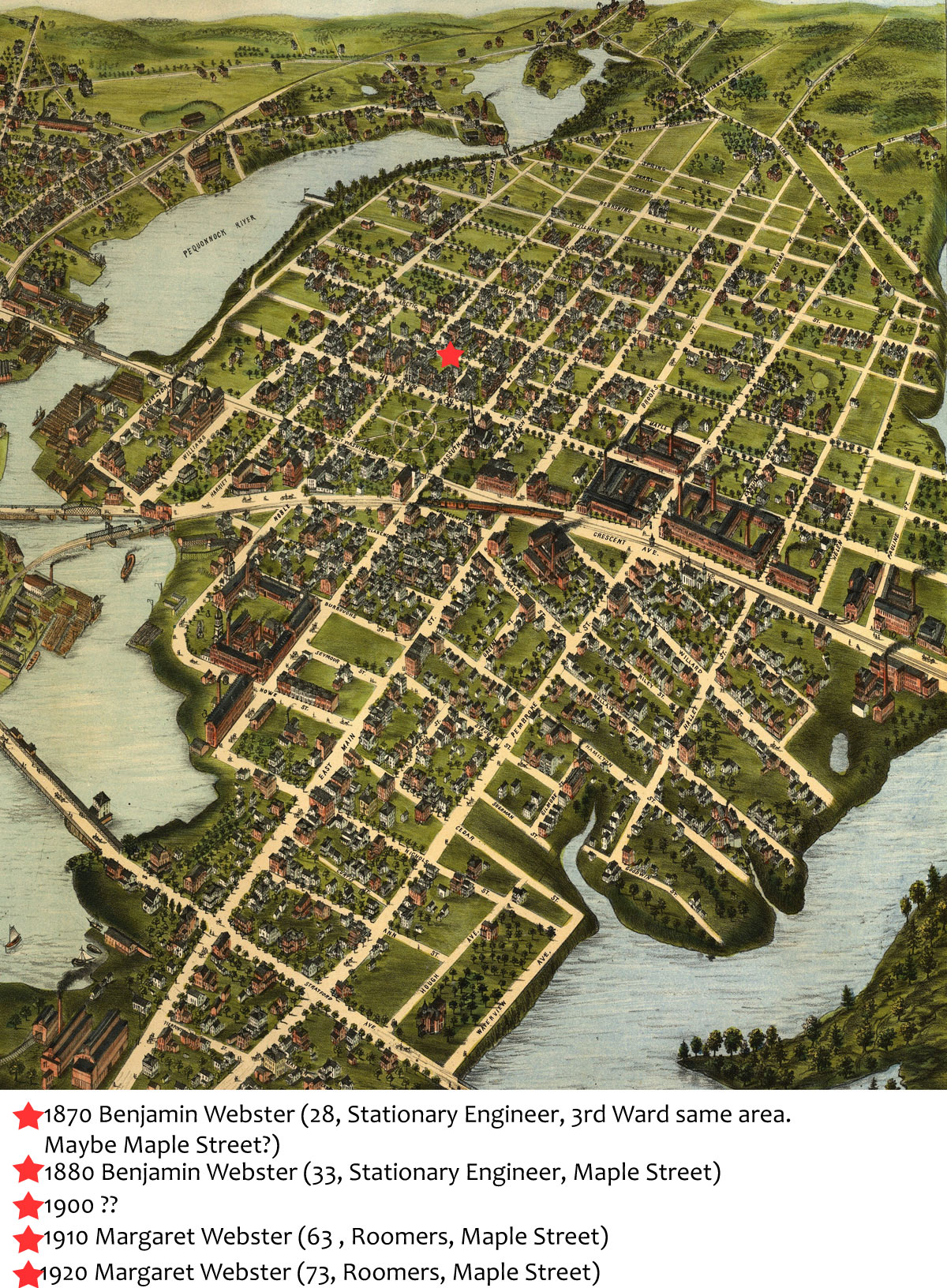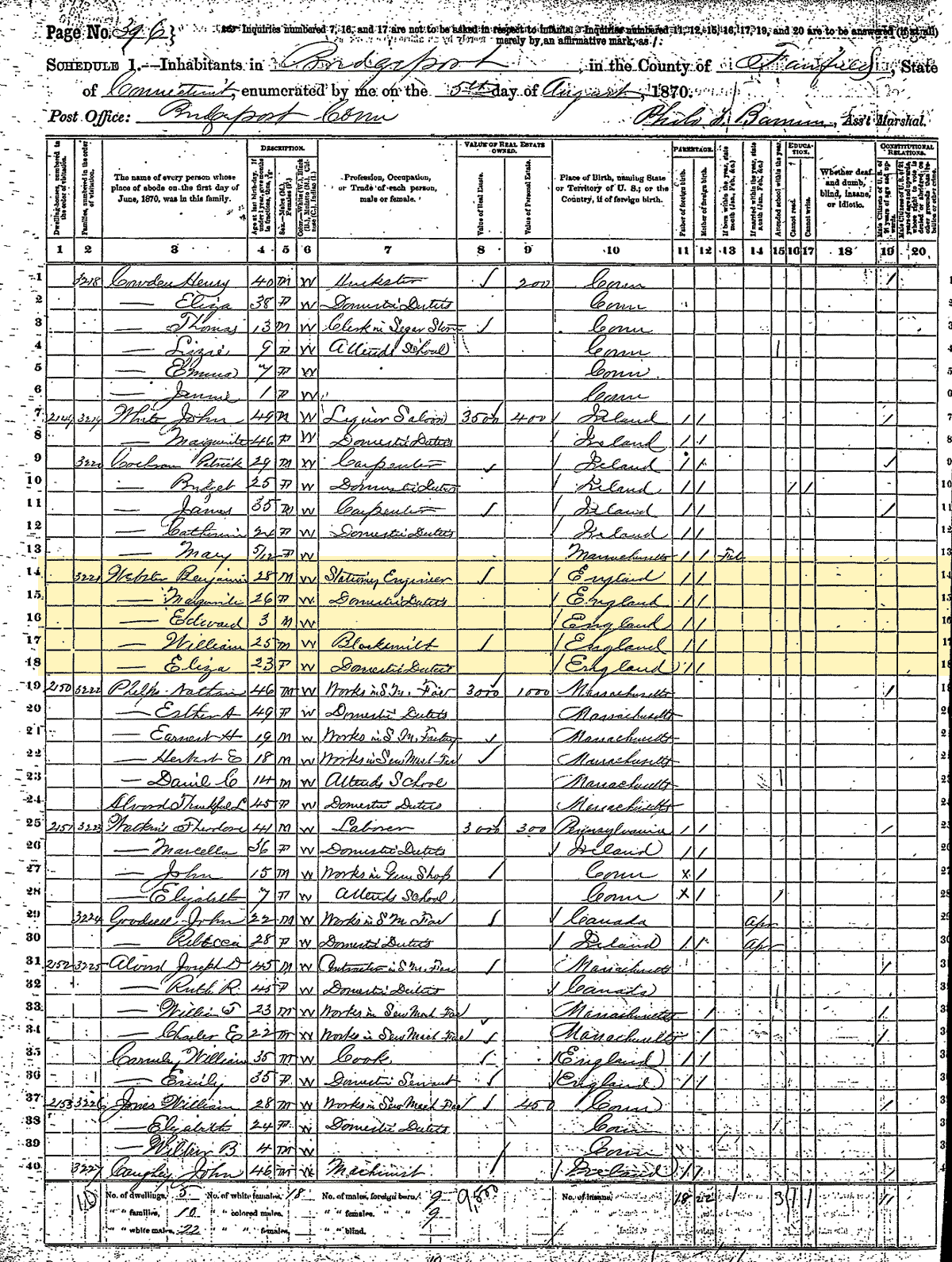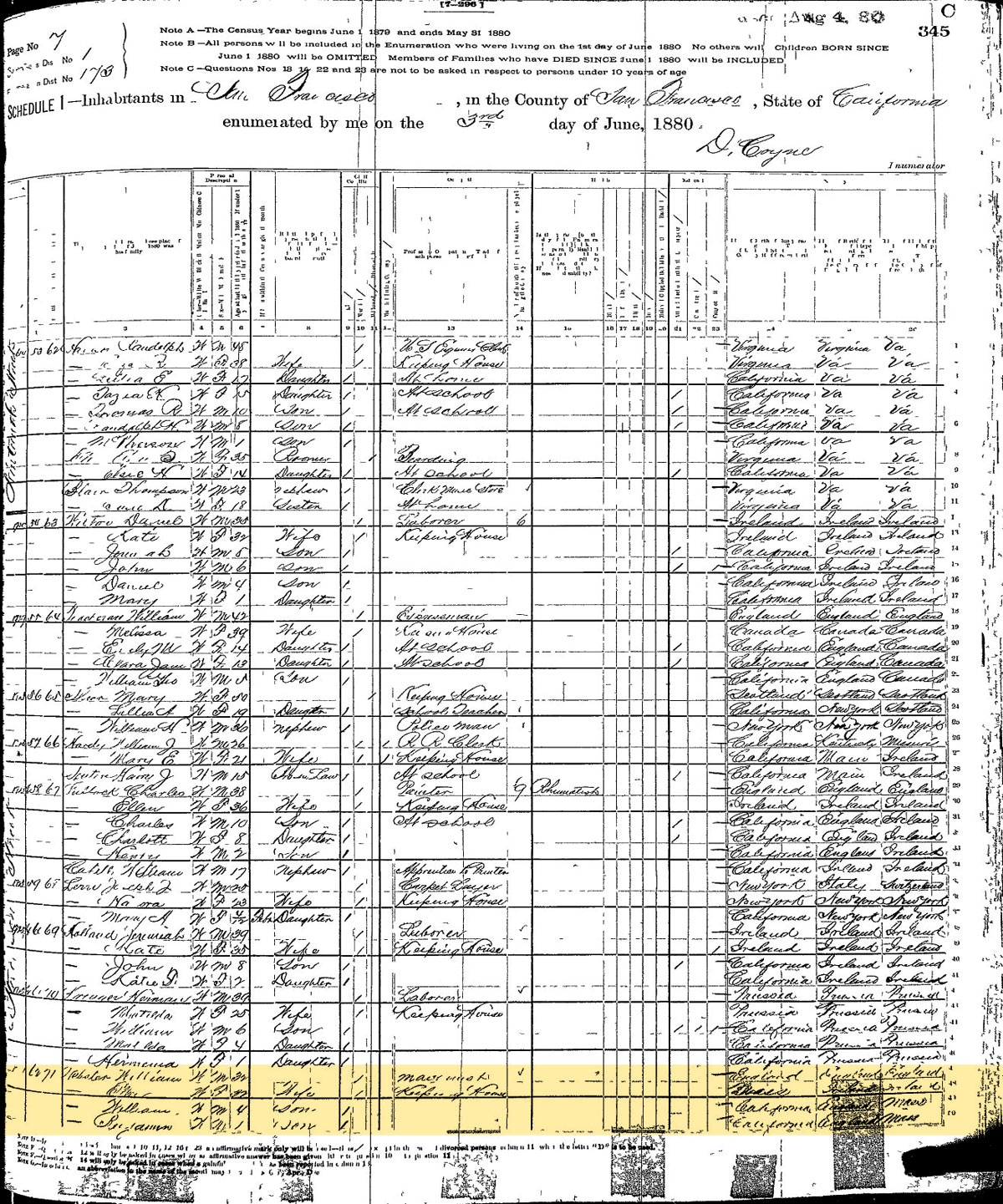Welcome
275 Maple Street, Bridgeport, CT
Between Park Street (NOT Park Avenue) and Noble Street
and between Barnum Street and Arctic Street one block north of Washington Park
This was the home of Benjamin and Margaret (Maggie) Calam Webster. It was a 17 room house. It is a block away from Washington Park -- originally a very nice area of Bridgeport; now a rather dicey, run-down area close to the center of the city, but one that still exhibits some beautiful architecture. Maple Street is just outside an area designated as an historic district.I've recently learned that Washington Park was one of the first "planned communities" designed by none other than P. T. Barnum! (of circus fame)
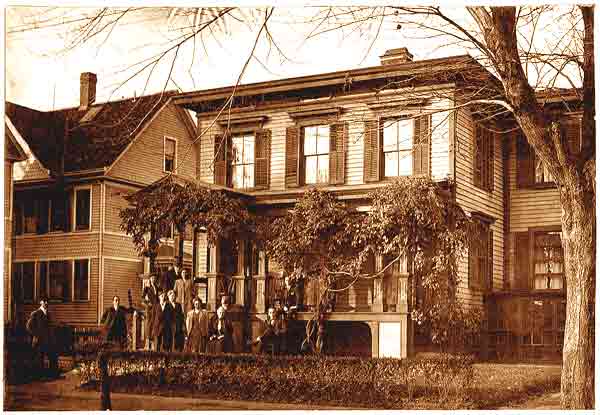
I believe many of these are Webster family members, but the only positive identifications I can make are marked.
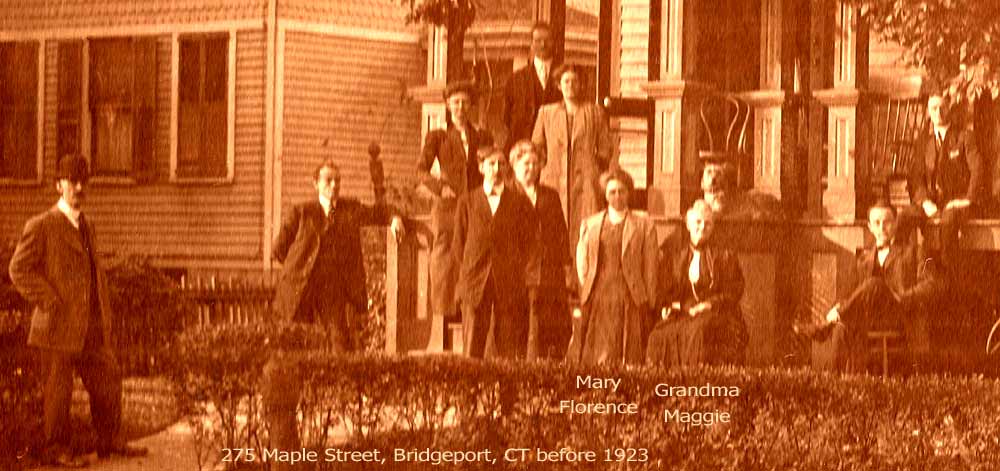
I've read that at the end of the 19th century Bridgeport rivaled New York City as a center of arts and activity. It had a very rich cultural life with many theatrical and musical offerings. From stories my mother told, I believe Mrs. Benjamin (Maggie) Webster moved in the center of the social life with her best friend, Mrs. Lee, being one of the most prominent ladies in Bridgeport.Bridgeport was also becoming a center of manufacturing and innovation. By the beginning of WWII it was such a center of manufacturing employment that even the most modest housing was at a premium. Since the war it has seen a continuing decline in industry and employment.
My mother, Margaret Gwendoyln Webster Northrop (Molly) spent a lot of time with her grandmother as a child. The information and anecdotes are my recollection of Molly's stories. My mother would have been about 11 when Maggie, my great-grandmother, died.
The house at Maple Street had a front porch covered with wisteria vines. It had a carriage house that was on the next street and had a kitchen in the basement. At some point, the Websters had "girls" to help with the household chores and I believe a number of them came from Ireland. Later in life (I imagine after the marriage of the children and death of Benjamin), Maggie kept it as a boarding house.In the summer the milk and butter were kept in the well (I believe it was in the basement) to keep them cool. Little Molly got herself in "hot water" when she decided to get water from the well in the basement instead of going to the well in the park to get water as she had been instructed.
Maggie kept a motherly eye on her "girls" and made sure they fulfilled their obligations to go to Mass. The girls sent most of their money "back home". One of her girls had scrimped and saved for months and months -- nearly a year -- to be able to afford a fashionable plume for her hat. The first Sunday the girl wore it to Mass, the unfortunate priest chose to make it a point of his sermon that his parishioners should be giving more to the church. Good Christians didn't waste their money on vain frivolities like feathers! Maggie was incensed that the priest would chastise her hard-working girls and try to shame them in front of everyone. Apparently she offered some words to the priest and made no secret of her disdain for the priest for anyone who cared to listen.
Here's a picture of Maggie and some of her boarders. Seems like she thoroughly enjoyed herself throughout her life.
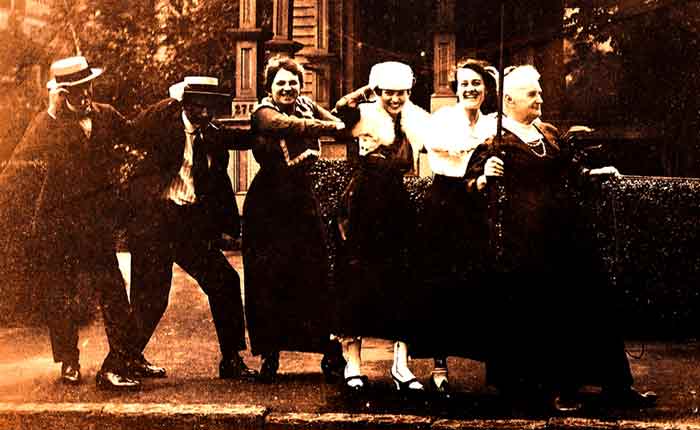
Census 1870
!870 3rd Ward, it is likely this is 275 Maple Street
| Benjamin Webster | 28 | M | W | Stationary Engineer | check | England | father foreign birth | mother foreign birth | b ~ 1842 | ||
| Margarite | 26 | F | W | Domestic Duties | England | father foreign birth | mother foreign birth | b ~ 1844 | |||
| Edward | 3 | M | W | England | father foreign birth | mother foreign birth | b ~ 1867 | ||||
| William | 25 | M | W | Blacksmith | England | father foreign birth | mother foreign birth | Benjamin's brother b ~ 1846,7 or 8 | b ~ 1845 | ||
| Eliza | 23 | F | W | Domestic Duties | England | father foreign birth | mother foreign birth | Could this be another sibling of Benjamin & William? | b ~ 1847 |
Next door neighbor, Nathan Phelps (Massachusetts) and a number of othre neighbors work in Sewing Machine Factory. Perhaps Wheeler and Wilson Sewing Machine Company.. In 1856 the company moved from Watertown, Connecticut to Bridgeport, Connecticut, occupying the old Jerome Clock Company's factory. Allen B. Wilson's achievement was in the area of inventing and perfecting sewing machines. Two of those were considered the most ingenious and beautiful pieces of mechanism: the rotating hook and the four-motion feed. He claims to have conceived the idea of a sewing machine in 1847. His first machine was built during the spring of 1849, while he was in the employ of a Mr. Barnes, of Pittsfield, Mass., a cabinet maker. In the same year he built a second and better machine, and "up to this time," says, "I had never seen or heard of a sewing machine other than my own."
Interesting link on Wheeler and Wilson
The Wheeler & Wilson Sewing Machine Company from Watertown in 1857. The factory was located across East Main Street from the district between Barnum Avenue and the railroad tracks; the last of its buildings was demolished in the early 1970s for a Housatonic Community College parking lot. Company employees (around 1000) swelled the population, and approximately one third of the large houses surrounding Washington Park were built by Wheeler & Wilson Company executives.
Or perhaps the Howe Sewing Machine Company In 1862 Elias Howe moved his sewing machine company to East Bridgeport, erecting a plant on the Pequonnock River south of the railroad tracks (buildings demolished in the early 1970s for the Bridgeport Jai Alai Fronton). He also employed around 1000 hands, and helped make East Bridgeport the acknowledged sewing machine capitol of the world in the last century. Other important industries located around the periphery of the residential district included the Winchester Arms Company, the Bridgeport Brass Company, and the Union Metallic Cartridge Company. By 1869 it was estimated that East Bridgeport contained one-fourth of the population and three-fourths of the manufacturing capital of the entire city.[5]
Finally, in 1854, his lawsuits were successful, and Elias Howe was recognized as the rightful owner of the patented design. From this point on, Howe began to receive royalties on every machine produced in the United States, and other manufacturers, including Isaac Singer, were required to pay Howe the royalties that were due him. Howe became a wealthy man after his impoverished beginnings. When the Civil War erupted, Howe joined as a member of the 17th Connecticut Volunteers. After serving, he moved to Bridgeport, Connecticut and established his own sewing machine plant there. Elias Howe, inventor of the sewing machine, died in 1867 in Brooklyn, New York.from http://www.netstate.com/states/peop/people/ct_eh.htm
from http://www.livingplaces.com/CT/Fairfield_County/Bridgeport_City/East_Bridgeport_Historic_District.html
1870
1880 275 Maple Street Bridgeport
| Benjamin Webster | W | M | 33 | mar | Stationary Engineer | England | England | England | b ~ 1847 | ||
| Margaret Webster | W | F | 32 | wife | Keeping House | England | England | England | b ~ 1848 | ||
| Edgar Webster | W | M | 12 | son | At School | England | England | England | b ~ 1868 | ||
| Mary F Webster | W | F | 10 | dau | At School | Connecticut | England | England | b ~ 1870 | ||
| Harry Webster | W | M | 9 | son | Connecticut | England | England | b ~ 1871 | |||
| Aubrey | W | M | 1 | son | Connecticut | England | England | b ~ 1879 |
1880

1880
1900 Florence Webster Broad Street, Boarder b Nov 1868 age 31 b Bridgeport, CT parents England, England, Corset Stretcher employed 2 months June 2, 1900
Berkshire
| Edgar Webster |
Head | W | M | Oct 1867 | 32 | married 10 years | 3 children all living | England | England | England | emigrated 1868 | years in US 31 | Not naturalized? | Toolmaker | home owned | mortgaged | home not farm |
| Bertha Webster |
Wife | Dec 1868 | 31 | New York | Germany | Germany | |||||||||||
| Earl F | Nov 1891 | 8 | At school | ||||||||||||||
| Edgar | Jan 1893 | 7 | At School | ||||||||||||||
| Lillian | April 1898? | 4 | |||||||||||||||
1900 Bridgeport Jane Street 9th Ward
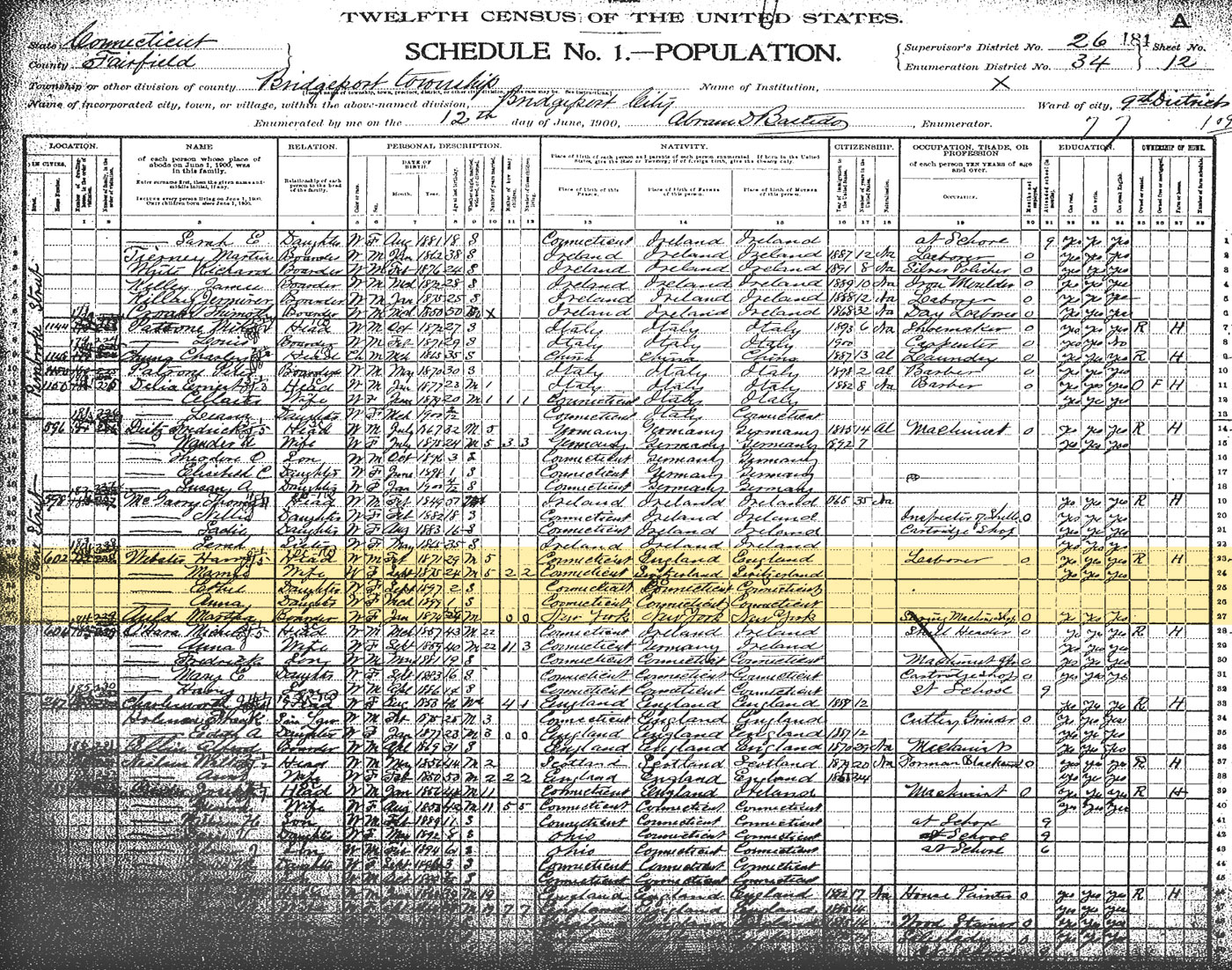
| Harry Webster | Head | W | M | Feb 1871 | 29 | married 5 years | 2 children all living | Connecticut | England | England | Laborer | home rented | home not farm | ||||
| Mamie | Wife | Sept 1875 | 24 | married 5 years | 2 children all living | Connecticut | Switzerland | Switzerland | |||||||||
| Ethel | Daughter | Sept 1897 | 2 | ||||||||||||||
| Anna | Daughter | Mch 1899 | 1 | ||||||||||||||
| Martha Auld | Boarder |
San Francisco
| 1869 |
|
||
|
http://www.zpub.com/sf/history/phs7.jpg |
|||
| 1870 | By 1870 San Francisco had become the tenth largest city in the United States. Everywhere one looked -- hotels, restaurants, parks, churches, synagogues, schools, libraries, academies -- there were signs that the United States now enjoyed a flourishing urban center thousands of miles in advance of the frontier. One sure sign of this developing urbanism was a maturing taste for art and the presence in the city of a growing number of artists. --Art and the City - By Dr. Kevin Starr |
from http://www.zpub.com/sf/history/sfh2.html
1880 San Francisco 11th Ward ? Street
Eleventh Ward—Bounded by the southerly line of Ridley street, the southerly line of Ridley street produced due west to the Pacific Ocean, the southerly line of Market street, the westerly line of Seventh street, and the southerly line of Channel street on the north; by the waters of the Bay of San Francisco on the east; by the southerly line of the City and County of San Francisco on the south; and by the waters of the Pacific Ocean on the west. Number of Precincts—thirty-three.
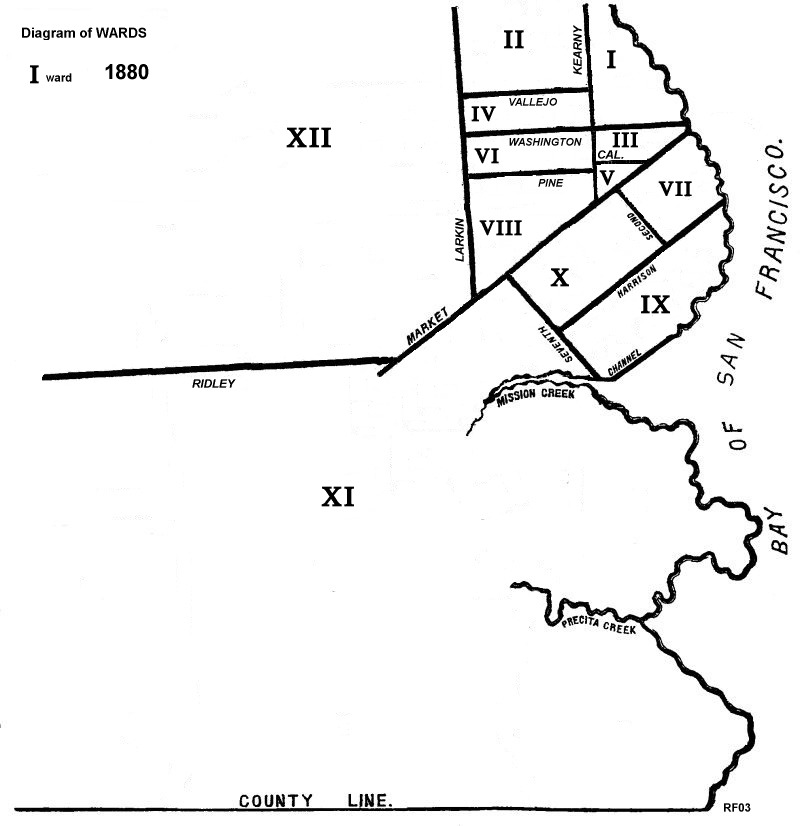
The Street may be Stevenson Street which may put it around 6th and 7th street.
from http://www.davidrumsey.com/luna/servlet/detail/RUMSEY~8~1~30522~1140049:County-map-of-the-state-of-Californ
http://www.davidrumsey.com/maps1140049-30522.html
look further for photos http://caviews.com/sf.htm
another great resource http://foundsf.org/index.php?title=The_Silver_Era,_1860-1870
"San Francisco is a mad city, inhabited for the most part by perfectly insane people whose women are of remarkable beauty." —Rudyard Kipling
San Francisco 1870 "Feb. 5. Golden Gate Iron Works destroyed by fire. . . .Two thousand children rehearse at Mechanics’ Pavilion for the Grand Concert." "Feb. 26. Last Urso Concert. . . .Festival netted $19,412. . . .Francis Dumartheray died of apoplexy. . . .Iron Ship Golden Gate arrived from Liverpool in 100 days—the shortest passage on record." "May 25. The corner stone of the new U. S. Branch Mint is laid, with Masonic ceremonies." http://www.sfgenealogy.com/sf/history/he870.htm
1880
| William Webster | Head | W | M | Feb 1871 | 32 | married 5 years ~ 1866 | 2 children all living | Connecticut | England | England | Laborer | home rented | home not farm | ~ 1839 | ||||
"WEBSTER--San Francisco, December 16---Wife of W. B. WEBSTER, a daughter." Source: Sacramento Daily Record-Union, 21 Dec 1876, p.2. Transcribed by Nancy Pratt Melton.
"WEBSTER--San Francisco, Nov. - Wife of W.B. WEBSTER, a son." Source: The Daily Union (Sacramento, CA), 9 Nov 1874. Transcribed by Betty Loose. http://www.sfgenealogy.com/sf/vitals/sfbirwa.htm
San Diego to Los Angeles in 1871
In 1871 there was a daily stagecoach run from the Cosmopolitan Hotel in Old Town to Los Angeles. It was a 35 hour trip. The cost was $10 plus meals according to a sign in the Seeley Stable Museum.
To put that in perspective, I’ll use the average wages from 1870. That $10 would be 3.2 days wages for a skilled blacksmith, or 2.4 days wages for a skilled carpenter, or 8 days wages for an unskilled laborer.
Translating that back from eight days unskilled labor then to minimum wage today would be $576 (let’s assume $9 per hour x 8 hours x 8 days).
Today the travel time for 125 miles from SAN to LAX airports is 2 hours 18 minutes.
Today the trip would take, oh, 5 gallons at let’s say $4.20, or $21 of gas assuming you own a car. Let’s assume around $.30 per mile cost for the vehicle, or another $37 for the vehicle. That’s a total of $58. At $10 an hour, let’s round that to 6 hours. http://outrunchange.com/2012/06/18/travel-cost-by-stagecoach-in-1870s-part-one/
Background
A setting worthy of a Henry James novel, Washington Park in Bridgeport, Conn., was the very model of a modern urban neighborhood. Families of factory managers, bankers, and merchants lived in three dozen high-style Victorian houses surrounding a five-acre landscaped square, thus living out an 1851 vision of P.T. Barnum, the circus impresario, one-term mayor of the coastal city and developer of Washington Park.Washington Park was created by P.T. Barnum in the mid-19th century. Though most famous for his circus, Barnum was also an urban planner, a real estate developer, and even mayor of Bridgeport, and his marketing skills helped him convince wealthy residents to build expansive homes around the a five-acre English walking park with a Victorian bandstand that he also built. Named Washington Park, it also gave its name to the surrounding community.
The neighborhood's character changed several times during the 20th century. Around World War I, nearby factories attracted immigrant laborers and led upper-class homeowners to move away; their mansions became rooming houses and multi-family homes that met demand for worker housing. After 1950, loss of manufacturing jobs and suburban flight created a poorer, deteriorating neighborhood, and while the "back to the city" movement of the early '80s brought some degree of reinvestment, it also produced unhealthy speculation. The bottom came in the early '90s: the real estate market collapsed, a recession hit, and drug epidemics helped produce the highest homicide rate in the state. The downward spiral continued as owners, struggling with lower rents, abandoned both residential and institutional property; homeowners who did remain saw their equity plummet and had to witness rampant arson, theft and vandalism.
Elegantly restored rowhouses characterize the revitalized Washington Park neighborhoodfrom http://www.nationaltrust.org/housing/casestudy_CT_WashingtonPark.html
Once one of Bridgeport’s most prestigious neighborhoods, Washington Park became one of its most socially and economically distressed in the 1990s. Created at the turn of the century by P.T. Barnum, of Barnum & Bailey Circus fame, Washington Park was one of the country’s first “planned communities” featuring beautifully designed Victorian homes built around a magnificent 5 acre park. But as Bridgeport’s fortunes declined, so did Washington Park’s. A century later, Washington Park became a haven for drug and criminal activity and the once majestic homes had become blighted and abandoned. Residents who remained in the neighborhood lost equity in their homes, feared walking the streets, and had little or no voice in the destiny of the neighborhood. In recent years, the neighborhood has seen the beginnings of a renaissance which has also fueled increased speculation and growth pressures.
MHA’S Comprehensivehttp://www25.uua.org/uuhs/duub/articles/ptbarnum.html
youtube
http://www.youtube.com/watch?v=HITLVYPcXXY
The rise of manufacturing in the state, of course, reflected the emergence of industrialization nationwide in the decades following the Civil War. But Connecticut’s extraordinary inventiveness and expertise, evident long before the war between the states, provided a special advantage. So, too, did the growth of an effective rail network, dominated by the New York, New Haven and Hartford rail line and the existence of huge capital resources in the state, largely provided by the state’s insurance industry, which virtually doubled in size from 1875-1900.
The most significant resource for Connecticut’s late 18th century eco¬nomic expansion, however, was a massive pool of unskilled labor provided by a dramatic influx of immigrants into the state in the waning years of the cen¬tury. In 1870, native-born Americans composed 75% of Connecticut’s popula¬tion: by World War I that figured held fallen to 35%.
Connecticut’s first experience with sudden population shifts came in the 1850s when substantial numbers of Irish arrived in the state to escape the great potato famine. But the Irish migration of the mid-1800s paled in comparison to the massive movement of southern and eastern Europeans to the state between 1890 and 1910. In 1870 there were 100 Italians in Connecticut: in 1920 there were over 80,000. The number of Poles in Connecticut in 1920 stood at 46,623, up 50% from 1900. Similarly, thousands of immigrants from Russia and Lithuania poured into the state at the close of the century, fleeing the political and economic instability of Europe in search of a better and more stable life in America. In 1920, 376,513 Connecticut residents had been born abroad and an additional 421,133 were first-generation Americans.
Immigration and industrialization transformed Connecticut from a rural to an urban society. By 1910 the rural population of the state (those living in towns under 2,500) had declined to 114,000, while city-dwellers numbered well over 600,000. Bridgeport grew from a town of 30,000 in 1880 to a metropolis of over 100,000 in thirty years.
Despite a half century of vigorous political activity in the state by such women’s rights advocates as Isabella Beecher Hooker, Grace Gallatin Seton and Katherine Houghton Hepburn, Connecticut’s established male order re¬lentlessly opposed women’s suffrage, fearing that an infusion of new voters would destabilize traditional political arrangements. With the political deck stacked firmly against them, Connecticut’s suffragettes were less able to focus public attention on issues of social welfare than were their peers in other states. A period of vigorous political and social reform in many sections of the coun¬try, Progressivism largely passed by Connecticut.
Connecticut’s cultural life in the decades following the Civil War was as vigorous and electric as her politics were passive and restrained. Certainly the most famous cultural figure of the day was Hartford’s celebrated Mark Twain who lived in Connecticut from 1874 to 1891 and saw many of his most signifi¬cant works published in that period, including The Gilded Age, The Adventures of Tom Sawyer, The Prince and the Pauper, The Adventures of Huckleberry Finn, and A Connecticut Yankee in King Arthur’s Court. Close by Twain in the “Nook Farm” area lived Harriet Beecher Stowe, Charles Dudley Warner and Francis Gillette.
A similarly prominent cultural community grew up some years later in Old Lyme. Influenced by extensive study of the major French Impressionists, such gifted artists as Childe Hassam, Willard Metcalf and Henry Ward Rayer sought in Lyme the same lush light and gentle countryside that had so inspired them in France. Under the patronage of Florence Griswold, who transformed her attics and spare rooms into bedrooms and her outbuildings into studios for the use of the artists, the “School of Lyme” flourished in the early years of the twentieth century and exerted a major influence on the course of American art.
The development of the theater, too, felt a significant Connecticut influ¬ence in this period. Just upriver from the “Connecticut Impressionists” lived the talented and eccentric actor William Gillette. Gillette is perhaps most fa¬mous for his long-standing identification with the role of Sherlock Holmes, which he played in hundreds of performances across the nation. But theater historians emphasize his great influence on American acting itself in his development of a “natural” style.
As did other sections of the nation, too, Connecticut enjoyed widespread prosperity throughout the decade. While its distance from raw materials and national markets and the comparatively high wages demanded by its skilled labor force put the state at a competitive disadvantage, all economic indicators registered well above normal for 1922 to 1929. Most Connecticut industries swiftly and successfully made the difficult transition from the production of war materials to peacetime products. Bridgeport’s experience was typical. A major munitions center in the war years, Bridgeport turned in the early twenties to the emerging automotive and electrical industries. An important new industry—the manufacture of aviation engines and accessories—emerged, and the extraordinarily rapid growth of Pratt and Whitney Company, Hamilton Stan¬dard Propellers, Chance Vought Company, Sikorsky Aircraft and United Air¬craft soon made Connecticut a leader in the aviation industry. Balancing these gains, however, was the collapse of the state’s once-vital textile industry. At¬tracted by low wages, favorable taxes and access to raw materials, Connecti¬cut’s cotton textile industry moved south in the 1920s, closing a third of its plants in the decade and putting 5,000 laborers out of work, most of them in the eastern section of the state.The twenties saw the ascension in Connecticut, as in the rest of the nation, of the businessman as a civic and, indeed, a cultural hero. The classic business virtues of efficiency, rational planning and cost effectiveness provided the basic credo of government at both the state and local levels, while a passion for “scientific management” swept Connecticut schools, churches and voluntary organizations.
From http://www.ctheritage.org/encyclopedia/ct1865_1929/overviewct1865_1929.htm
1903
Two-thirds of all U.S. motorcars sell at prices below $1,375, but most are too small, too light, and too unreliable to present serious competition to the horse and buggy, much less the railroad.
